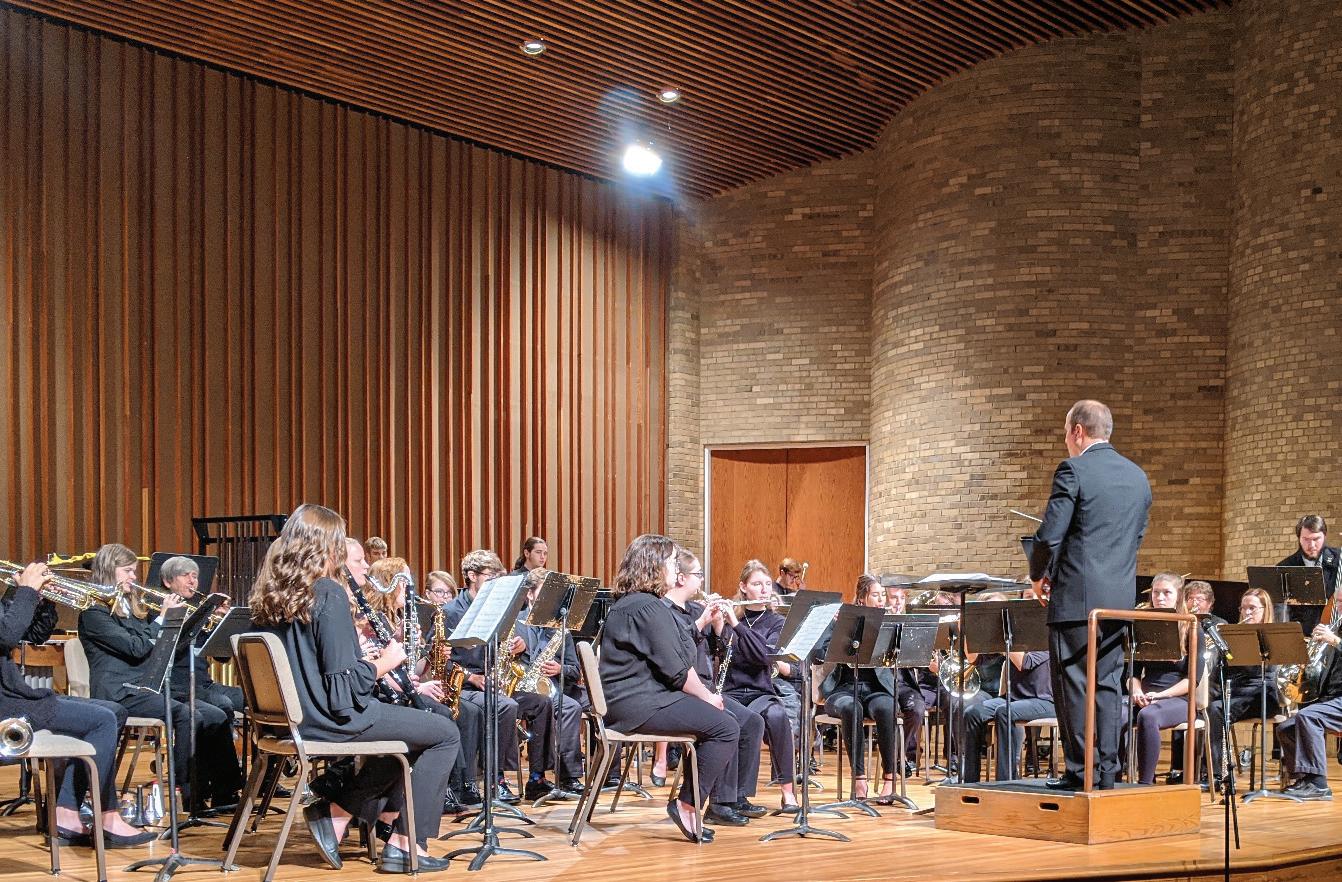
15 minute read
FINE ARTS
The newly formed, all ages, all skill levels band performing in Bjorling Recital Hall. “We are making music in an upbeat and fun environment where students and adults can learn together,” says Mark Kruger, trumpet player and professor of psychological science.
A B A N D T H AT W E L C O M E S A L L
Advertisement
It’s time to dust off that old tuba.
The newly formed Gustavus Campus Band held its inaugural performance in November and is on the hunt for new members.
The 40 piece ensemble consists of Mankato-Saint Peter community members, Gustavus faculty and staff, and students. The idea for the band grew out of the need for a third band due to booming numbers in the Gustavus band program, as well as the need for conducting outlets for the rapidly expanding music education major. Brady Krusemark ’05, Mankato West Director of Bands and Gustavus alum, has been hired to lead the group. He says the mix of ages and backgrounds brings unique perspectives and experiences to music making. “We talk a lot about how music has the ability to bring people together,” he says. “Our members might lead very different dayto-day lives, but when we come together to make music, it’s as if we’ve known each other for years.”
Lauren Hecht, associate professor in psychological science, has played clarinet since the fourth grade. But after moving to Saint Peter in 2010, she hadn’t found a group that fit her schedule. She joined the band playing bass clarinet this fall. “My experience with the Gustavus Campus Band has reminded me of all the aspects I love about playing in a band,” she says. “The positive attitude, dedication, connecting with others, listening closely to one another as we create a meaningful piece of music.”
Also in the band is professor in psychological science Mark Kruger. In true multidisciplinary fashion, he brings
a wealth of experience as a horn player to the ensemble, and his research as a psychologist has centered on brass performance.
Another key part of the ensemble is the leadership of student conductors and music education interns. During the first performance, two music education majors conducted pieces, and nine music education interns assisted the ensemble by playing secondary instruments and leading sectionals. “I believe this has been one of the best parts of this ensemble experience,” Krusemark says. “It’s always a joy to see conducting students develop and find their own leadership style. We’ve been able to hear their unique voices, learn from their perspectives and insights, and provide a safe space for them to take on the challenge of leading an ensemble.” For those who might be hesitating because it has been a while since they’ve tooted their own horn, Hecht encourages them to give it a try. “If anyone’s worried about their ‘chops,’ they should know that for every person who has been consistently playing their instrument, there are just as many who haven’t played for years, and there are students learning to play a second instrument.” Krusemark agrees. “Music-making can truly be a life-long endeavor,” he says, “and it’s never too late to get back into it.”
Interested in joining the band? If you’re in the area, don’t hesitate to join along. The band currently has openings for all instruments. It rehearses once a week on campus. For more information, contact James Patrick Miller, Douglas Nimmo Professor of the Gustavus Wind Orchestra at jpmgwo@ gustavus.edu.
Call for Artwork The Hillstrom Museum of Art invites artists age 18 years or older to submit one or two works for a juried exhibition related to cancer by artists who have been affected by cancer. Serving as juror for the exhibition will be a former curator of the National Gallery of Art in Washington, D.C. The exhibition, tentatively titled Cancer Never Had Me: Views by Artists, will be on view from Sep. 14 through Nov. 8, 2020. It will be shown concurrently with another exhibition, a focused showing of works in the collection of the Hillstrom Museum of Art by artists who died of cancer, including Grant Wood (1891-1942), Robert Henri (1865-1929), and Wanda Gág (1893-1946). Both exhibits will be on view during Nobel Conference 56: Cancer in the Age of Biotechnology. The deadline for submission is June 1. There will be cash prizes for first, second, and third place works. Further guidelines and instructions for submission are at gustavus.edu/hillstrom.
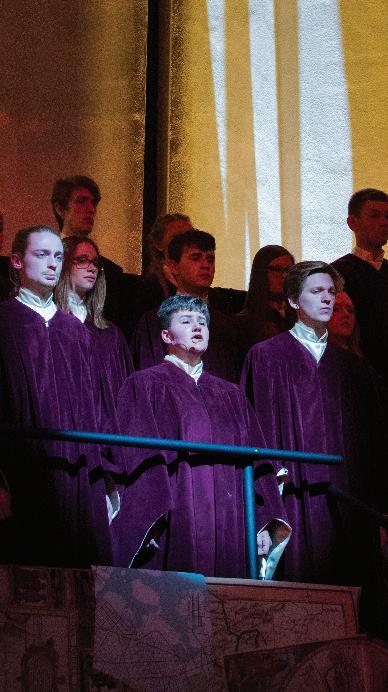
Megan Nipe ’21 (Burnsville) in Christmas in Christ Chapel: Love Beyond Borders. Says Gustavus Chaplain Siri Rev. Siri Erickson, “The incarnation as we see it in the nativity story is an event of God’s spirit taking shape in the human body of Jesus that reveals God’s ability to transcend the boundary between heaven and earth, between spirit and flesh.”
NEXT
March 19-22 | Partnering with Gravity: The Gustavus Dance Company in Concert, 8 p.m. (2 p.m. on Sunday), New Laboratory Theatre
March 21 | Gustavus Wind Symphony and Gustavus Chamber Winds Concert, 1:30 p.m., Bjorling Recital Hall
March 29 | Choir of Christ Chapel and Lucia Singers Spring Concert, 2 p.m., Christ Chapel
April 18 | Gustavus Wind Orchestra Midwest Tour Home Concert, 7 p.m., Bjorling Recital Hall
April 26 | Percussion Ensemble Concert + Brassworks!, 1 p.m. + 3:30 p.m., Bjorling Recital Hall
May 2 | Senior Honors Recital, 1:30 p.m., Bjorling Recital Hall
When it opened in 1984, Lund Center was the jewel of the MIAC and one of the best facilities in NCAA Division III sports. It’s forward-looking design—which allowed spectators to catch gymnastics, hockey, swimming, and basketball in the same building at the same time—was unparalleled, earning it the distinction of national facility of the year. Lund was also one of the first college sports facilities in the U.S. to give equal access to men and women, which ushered in a new level of excellence for all of Gustavus athletics. “We made the institutional commitment that athletics was a way to facillitate growth and development in young people,” says Tim Kennedy ’82, who was a sports information intern at the time. (He is now vice president of marketing and communication.) And we made quite an impression on our opponents. Says Kennedy, “When teams came in, their jaws dropped.”

Heritage
to Give So Many Ways
YOU’D BE SURPRISED WHAT GUSTIES CAN DO.
What does a herd of cattle have to do with a pipe organ? Or a grand piano with a load of grain? The answer is: All of these things have great value. And all of these can be donated to Gustavus.
Like other non-profit organizations, Gustavus can accept gifts of tangible personal property and real estate. Sometimes, items are received as gifts in kind, meaning the College can put them directly to use on campus. This was the case recently with the pipe organ and grand piano. With other forms of property, Gustavus goes through proper channels to sell the items and then puts the proceeds to use, in accordance with both the donor’s wishes and the College’s needs.
Gustavus cannot accept everything that is offered, however, even items appraised to have significant worth. The College archive is regularly offered artifacts that are believed to have historical value, but it has strict rules on what it can accept. It’s the same with the Office of Advancement. Gustavus has accepted farmland and lake cabins, office buildings and stock portfolios. Imagine, a farmer points to the last truck of corn leaving his property at harvest time and says, “That’s for the College.” There are many ways to give. If you have an asset that you think might have value for Gustavus, contact the Office of Advancement. We will work to find an arrangement that is beneficial to you and beneficial to the College.
PLANNING YOUR PHILANTHROPY
You meet with your accountant at tax time. You consult a financial planner to prepare for retirement. When it’s time to update your will, you turn to an attorney. But what about your philanthropic giving? More than 60 percent of people who donate say they would like to give more. Their biggest concerns are finding out if increased philanthropy can fit within their personal finances and making sure their gifts will have real impact. There are professionals who can answer those questions. Just as accountants, attorneys, and financial planners help manage our money, gift planners can provide expert advice on how to maximize our giving. The first lesson in charitable giving is that it can take many forms—each with its advantages for the donor and for the recipient. Here are the most common ways that alumni and friends of Gustavus support the College.
CASH When we think of charitable giving, what first comes to mind is writing a check. Gifts by check and credit card go to work immediately, especially to the Gustavus Fund.
PROPERTY Donations of real estate can be remarkably flexible in serving the needs of both the College and the donors. Gifts can provide income for you and provide long-term benefit to the College.
DONOR ADVISED FUND A popular way to give is through your donor advised fund. Your contributions grow in a managed account, just like a mutual fund. You decide where and how much to donate.
IRA DISTRIBUTION If you are over age 70½, you can make a qualified charitable distribution from your IRA. A direct transfer to Gustavus can count toward your required minimum distribution.
PLANNED GIFTS Planned gifts in your estate and retirement plans establish your philanthropic legacy. The options are varied—with some providing reliable income to you as well as a promised gift to Gustavus. Will
STOCKS Gustavus regularly receives gifts of appreciated stock. Donating stock can provide greater tax advantages than giving cash, and the proceeds from the stock sales can be directed to specific programs at the College.
WHY I GIVE: Kaela Poepping Cusack ’05
“NOW I AM ABLE TO GIVE MORE, AND MY COMPANY KICKS IN WITH A MATCH.”
Looking back at how Gustavus prepared me for my career, I appreciate that my education was so well rounded. I have fond memories of “Zen & Japanese Culture” and “God Today”––two unrelated classes that broadened my perspective on life. My current job blends art and science, in that I have to think critically about data but also hypothesize around what the data says and how to act on it. Thanks to my major in communication studies, I had plenty of practice writing, speaking, and working in groups, which are critical skills in the workplace.
Because college was such an influential and pivotal time in my life, it’s only natural that Gustavus was one of the first places I gave to after graduation. I didn’t contribute a lot (maybe $25 or $50 per year), but I wanted to get in the practice of writing that check. Charitable giving was something my parents had instilled in me growing up.
Giving is something I am so passionate about. Adobe is a phenomenal company to work for, and they are extremely generous and encouraging of philanthropic involvement. Not only do they match my donations dollar for dollar, but I can also Cusack earned her degree in communication studies at Gustavus and her MBA at Butler University. She has worked for Adobe for more than a decade and now serves as a Solution Consultant specializing in business analytics. Kaela lives in Indianapolis with her husband and two children.
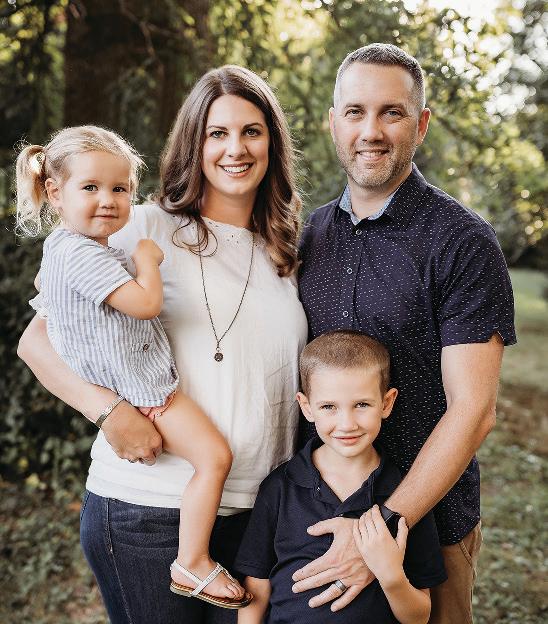
“earn” charitable contributions by volunteering. For every 10 hours of time I serve, I am awarded $250, which I can direct to any organization of my choosing.
I also look for other opportunities to stay connected with Gustavus, even here in Indianapolis. Recently, I discovered a Gustie alum who lives around the corner from me. Our kids are about the same age and we both work remotely, so we meet up weekly to get away from our home offices. We’ve even organized events together for the local alumni chapter.
Company Max Dollar for Dollar Match TOP GUSTIE EMPLOYERS AND THEIR MATCHING PROGRAMS
UnitedHealth Group up to $5,000
US Bank $1,000
3M $1,000 Ameriprise $1,500 Thrivent $20,000 General Mills $1,000 Cargill $1,000 Medtronic $5,000
EACH YEAR, U.S. COMPANIES DONATE $2 TO $3 BILLION— to match charitable giving by their employees and retirees. Yet only seven percent of eligible donors at such companies ever submit a request. This means an estimated $4 to $7 billion in matching funds are left on the table each year. Some twothirds of Fortune 500 companies have matching programs. Many require a minimum donation of only $25. Does your company have one? Ask.
WHY I GIVE: Jon Kietzer
“ALTHOUGH I WAS NEVER A STUDENT AT GUSTAVUS, I HAVE BEEN A FAN FOR YEARS.“
I went to a couple of nearby colleges—Martin Luther College and Mankato State University––and then to the University of Iowa for my master’s. After finishing my graduate degree, I got a job as organist at House of Prayer, a Lutheran church in Richfield with a lot of Gusties.
I also filled in as interim organist at Gustavus for David Fienen, when he took sabbaticals. I experienced chapel services, life on campus, the Gustavus community. As I always say, Chaplain Elvee converted me to Gustieism. It was wonderful working with him. When I was a young guy starting out in the business, Elvee taught me a lot about music and worship.
It was during this time, in conversations with Chaplain Elvee, that I decided to endow the cantor position at Christ Chapel. The cantor is the person who leads the assembly of believers in song. Being an organist, I’m a little biased, but I think the organ is the best instrument to lead worship. I like guitars on Saturday night, and on Sunday morning I like the organ.
I first wrote my intention for the cantor position into my will. But then, about 10 years ago, I did some more serious estate planning. My dad had been a farmer, but he didn’t want me to be a farmer. Instead, he encouraged my musical interests. He did leave me his land, though, distributed over five different farms. When I first started my estate planning, I created a charitable remainder trust with the College. A year ago, I did that a second time. There are still two farms left that will ultimately go to fund the endowment.
I wanted my giving to go to something related to church music, and I have had a great connection to Gustavus. This was the place. I knew that Gustavus would welcome the gift, and that it would be put to good use.
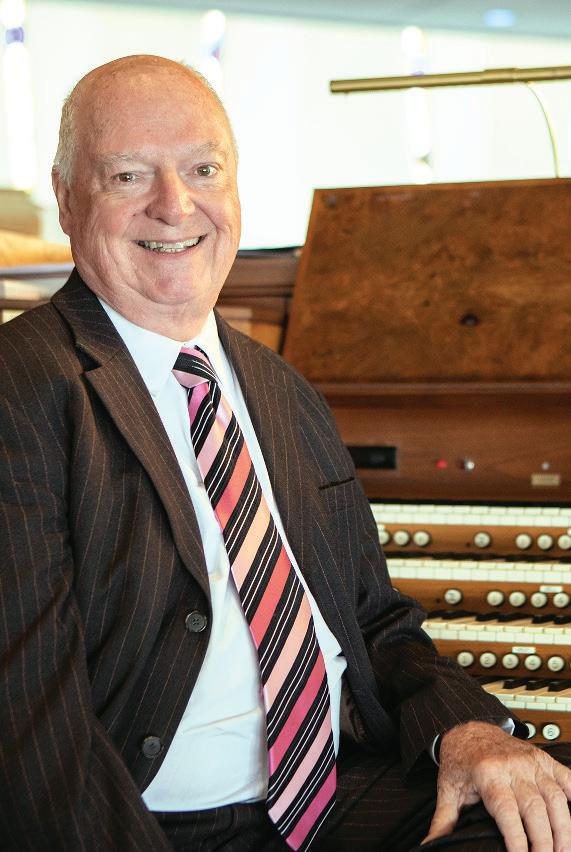
Kietzer joined the staff of House of Prayer in 1973, where he still serves as organist. He’s held leadership roles in various national organizations as well as Gustavus Friends of Music.
Ultimately, the whole purpose of creating this endowed position is to ensure the tradition of the cantor and organ. Worship based in hymns is less subject to the fleeting styles of the day. Hymns don’t always have to be old, but they do have to have substance and sustenance, not just emotion.
As I was sitting in Christ Chapel recently, I was reminded why this is important. To see all the students; to hear the brass, the choir, the soloist, the student organist. Everything was there. You can do new and creative things with hymns, but they have a historical substance that has lasted for thousands of years. In making my gift, I hope this kind of worship continues for years ahead at Gustavus.
THE WORLD’S CHALLENGES, A SENSE OF PURPOSE, AND US
President Bergman unpacks the concept of vocation and how discerning it is our college’s calling card.
In your introduction to the Gustavus Acts Strategic Plan, you state that Gustavus is “an institution committed to vocation.” What does that mean? RB: To me it has a bit of calling and a bit of purpose combined with the will to embrace both.
How that manifests itself in life is not always simple. Think about the complexity of this for a 60-year-old, who has had a lot of lived experience and opportunities for discernment. Now think about how much more complex the process is for an 18-year-old. Still, the concept of vocation can be well understood when you take time to unpack it. It is clear in the two-pronged promise of our vision statement: We equip students to lead purposeful lives. We equip them to act on the great challenges of our time.
How does Gustavus guide students toward understanding and developing their vocations? RB: Magic happens when a student’s interests, passions, and callings—and the world’s needs—come together. At Gustavus, a student will fall in love with a new discipline. A faculty member will help them dive deeper into its context in today’s world. An alum will connect them with others doing related work. Student organizations and student employment provide practice and experience. All of these things take initiative and self-reflection on a student’s part—discernment around their gifts, passions, opportunities, and greater purpose in serving the world. What we do here at Gustavus is plant the seeds of that journey and give it space to grow.
How does the concept of vocation relate to the liberal arts? RB: There’s a road that connects our college majors with our current lives, but that road is usually not a straight line. For most
MEET PRESIDENT BERGMAN
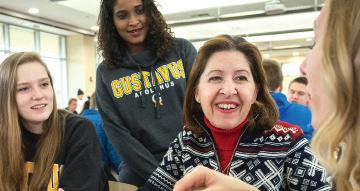
She’s excited to talk to Gusties about how they can show the world what Gustavus is and what it can be. Visit gustavus.edu/showtheworld for more details.
Washington DC April 20 New York City April 21 Boston April 22–23 St. Cloud June 22 Wilmar June 23 Sioux Falls June 24 Duluth June 29 Brainerd June 30
of us, when we look back 10, 20, 30 years, we can see the paths we traversed include side roads and intersections and forks. In my own life I have been a biomedical engineer, a business executive, a mom, a volunteer, and a college president, immersed in the disciplines of engineering, medicine, education, and business. The world is multidisciplinary. Full stop. Solutions to every major challenge in the world require innovative, creative thought between disciplines. The way to appreciate those disciplines is to immerse yourself in them. The world needs leaders who can come from multiple perspectives. That’s what Gustavus produces.
In the Lutheran tradition, VOCATION IS OUR CALLING WITHIN OUR SITUATION IN LIFE. It refers to more than our occupation and includes the personal, communal, and historical relationships, situations, and involvements in which we live today.






